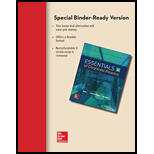
To determine: The arithmetic and geometric average return.
Introduction:
Total return refers to the total income from an investment. The total income includes the periodic incomes and the increase or decrease in the value of an asset.
Arithmetic average return refers to the returns that an investment earns in an average year over different periods.
Geometric average return refers to the return after compounding the average returns for multiple years.
Answer to Problem 21QP
The arithmetic average return is 0.10194 or 10.194% and the geometric average return is 0.0982 or 9.82%.
Explanation of Solution
Given information:
The price of the stock at the end of first year is $58.27. The price of the stock at the end of second year is $67.32, and the dividend paid is $1.10. The price of the stock at the end of third year is $61.46, and the dividend paid is $1.25. The price of the stock at the end of fourth year is $69.32, and the dividend paid is $1.45.
The price of the stock at the end of fifth year is 75.18, and the dividend paid is 1.60. The price of the stock at the end of sixth year is 84.32 and the dividend paid is 1.75.
The formula to calculate the total percentage returns:
The formula to calculate the arithmetic average return:
Where,
“∑Xi” refers to the total of observations,
“Xi” refers to each of the observations from X1 to XN (as “i” goes from 1 to “N”),
“N” refers to the number of observations.
The formula to calculate the geometric average return:
Where,
“R” is the annual returns for the investment,
“T” is the years of returns.
Compute the percentage return for the second year:
The closing price of the stock is $67.32, and the beginning price is $58.27. The dividend received in the second year is $1.10.
Hence, the percentage return for Year 2 is 0.1741 or 17.41%.
Compute the percentage return for the third year:
The closing price of the stock is $61.46, and the beginning price is $67.32. The dividend received in the second year is $1.25.
Hence, the percentage return for Year 3 is 0.0684 or 6.84%.
Compute the percentage return for the fourth year:
The closing price of the stock is $69.32, and the beginning price is $61.46. The dividend received in the second year is $1.45.
Hence, the percentage return for Year 4 is 0.1515 or 15.15%.
Compute the percentage return for the fifth year:
The closing price of the stock is $75.15, and the beginning price is $69.32. The dividend received in the second year is $1.60.
Hence, the percentage return for Year 5 is 0.10718 or 10.718%.
Compute the percentage return for the sixth year:
The closing price of the stock is $84.32, and the beginning price is $75.18. The dividend received in the second year is $1.75.
Hence, the percentage return for Year 6 is 0.1448 or 14.48%.
Compute the arithmetic average return:
The return for the second year is 16.45 percent, the return for the third year is 9.29 percent, the return for the fourth year is (8.57 percent), the return for the fifth year is 14.15 percent, and the return for the sixth year is 16.29 percent.
Hence, the arithmetic average return is 0.10194 or 10.194%.
Compute the geometric average return:
Hence, the geometric average return is 0.0982 or 9.82%.
Want to see more full solutions like this?
Chapter 10 Solutions
Loose Leaf for Essentials of Corporate Finance
- Financial leverage Costco Wholesale Corporation (COST) and Wel-Mart Stroes Inc. (WMT)reported the following data (in milllions) for a recent year: Compute the return on stockholders equity. Round to one decimal place.arrow_forwardSelected information for Berry Company is as follows: Berrys return on equity rounded to the nearest percentage point is: a. 20%. c. 28%. b. 21%. d. 40%.arrow_forwardThe Castle Company recently reported net profits after taxes of $15.8 million. It has 2.5 million shares of common stock outstanding and pays preferred dividends of $1 million a year. The company’s stock currently trades at $60 per share. Compute the stock’s earnings per share (EPS). What is the stock’s P/E ratio? Determine what the stock’s dividend yield would be if it paid $1.75 per share to common stockholders.arrow_forward
- Ratio Analysis MJO Inc. has the following stockholders equity section of the balance sheet: On the balance sheet date, MJOs stock was selling for S25 per share. Required: Assuming MJOs dividend yield is 1%, what are the dividends per common share? Assuming MJOs dividend yield is 1% and its dividend payout is 20%, what is MJOs net income?arrow_forwardUse the extended DuPont equation to provide a breakdown of Computrons projected return on equity. How does the projection compare with the previous years and with the industrys DuPont equation?arrow_forwardA stock has had the following year-end prices and dividends: Year Price Dividend 0 $ 43.29 - 1 48.27 $ .48 2 57.19 .51 3 45.27 .60 4 52.19 .65 5 61.27 .73 What are the arithmetic and geometric average returns for the stock? (Do not round intermediate calculations. Enter your answers as a percent rounded to 2 decimal places, e.g., 32.16.) Arithmetic average return % Geometric average return %arrow_forward
 Survey of Accounting (Accounting I)AccountingISBN:9781305961883Author:Carl WarrenPublisher:Cengage Learning
Survey of Accounting (Accounting I)AccountingISBN:9781305961883Author:Carl WarrenPublisher:Cengage Learning Cornerstones of Financial AccountingAccountingISBN:9781337690881Author:Jay Rich, Jeff JonesPublisher:Cengage Learning
Cornerstones of Financial AccountingAccountingISBN:9781337690881Author:Jay Rich, Jeff JonesPublisher:Cengage Learning
 Fundamentals of Financial Management, Concise Edi...FinanceISBN:9781305635937Author:Eugene F. Brigham, Joel F. HoustonPublisher:Cengage Learning
Fundamentals of Financial Management, Concise Edi...FinanceISBN:9781305635937Author:Eugene F. Brigham, Joel F. HoustonPublisher:Cengage Learning Fundamentals of Financial Management, Concise Edi...FinanceISBN:9781285065137Author:Eugene F. Brigham, Joel F. HoustonPublisher:Cengage Learning
Fundamentals of Financial Management, Concise Edi...FinanceISBN:9781285065137Author:Eugene F. Brigham, Joel F. HoustonPublisher:Cengage Learning





